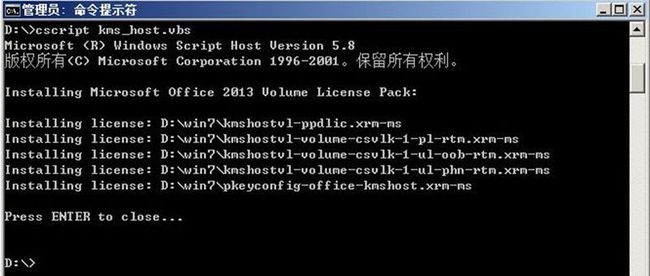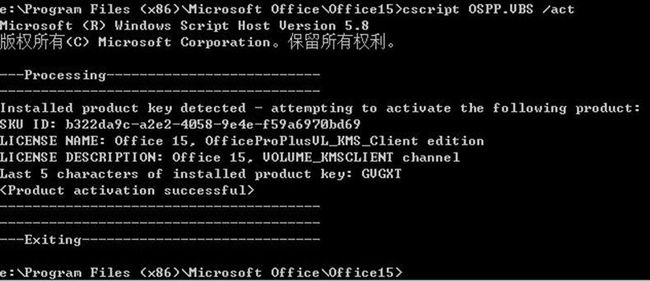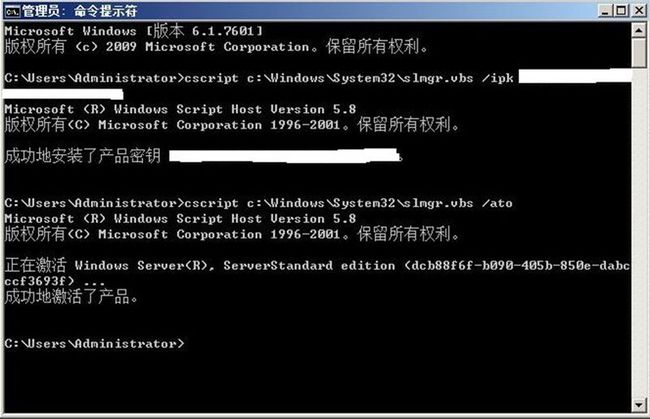Windows 2008R2部署Win 7/2008R2+Office2010(+2013)+Win 8/2012(+win8.1/2012R2) KMS激活服务器 - 沐雨无尘 - 51CTO技术博客
部署windows 2008 R2 KMS激活:
1、安装Windows2008R2w_sp1系统,加入域,配置好DNS;
2、以管理员权限运行cmd;
3、(可省略)查看当前KMS状态:cscript slmgr.vbs /dli
4、安装KMS Key:cscript slmgr.vbs /ipk
5、激活KMS Host(确保Internet连接的情况下):cscript slmgr.vbs /ato
6、发布KMS服务器到DNS上:cscript slmgr.vbs /sdns
7、开启1688端号,使KMS可以通过防火墙。打开控制面板,单击"允许程序通过Windows防火墙",选中"密钥管理服务"。
8、(可省略)重启Software Protection服务:net stop sppsvc && net start sppsvc
9、(可省略)检查KMS状态:cscript slmgr.vbs /dli
10、客户端激活:slmgr.vbs -skms kms-server-ip
注意:如果此步出错,运行slmgr -ipk xxx-xx-xx,再运行上一步
slmgr.vbs -ato
11、在KMS服务器上检查激活的数量:slmgr.vbs -dlv
Windows2008R2 KMS服务器支持激活Windows 7/2008R2
一般情况下,每个kms密钥直接激活6台服务器,并且这6台都可以作为kms服务器,这6台机器如果重装,每台共可以激活10次
部署Office2010(2013相同)KMS激活:
1、下载office2010 KMS主机许可证包,下载并运行KeyManagementServiceHost.exe
Office2013 KMS许可证包和2010不同,下载文件后打开命令行窗口,运行cscript kms_host.vbs
2、出现提示时,输入您的KMS主机密钥
3、出现提示时,继续进行激活(在KMS主机连接internet情况下)
4、客户端连接KMS服务器激活:
cscript ospp.vbs /sethst:
cscript ospp.vbs /act //激活
cscript ospp.vbs /dhistorykms //查看激活历史,确认是否已经和激活主机连接上了
注意:ospp.vbs 在 Office 安装目录,如 Office2010安装目录:C:\Program Files (x86)\Microsoft Office\Office14
Office2013安装目录:C:\Program Files (x86)\Microsoft Office\Office15
5、查看KMS服务器office激活的数量:slmgr.vbs /dlv bfe7a195-4f8f-4f0b-a622-cf13c7d16864
Office 2013 Activation ID:2E28138A-847F-42BC-9752-61B03FFF33CD
Office 2010 Activation ID:bfe7a195-4f8f-4f0b-a622-cf13c7d16864
手动导入客户端密钥:cscript ospp.vbs /inpkey:xxx-xx-xx-xx-xxx
部署Windows7 KMS激活方法同Windows2008R2(注意KMS host key系统要求)
1、导入KMS Host密钥:slmgr /ipk xxx
2、激活KMS Host:slmgr /ato(电话激活:slui.exe 4)
3、重启服务:net stop sppsvc && net start sppsvc
4、客户端连接激活:
slmgr /skms 10.0.0.1:1688(端口可选)
slmgr /ipk xxx-xx-xx-xx-xxx(可选,导入客户端密钥可转成KMS客户端版本)
slmgr /ato
部署(Windows2008R2 KMS服务器)添加支持Windows 8/2012(+添加支持Windows 8.1/2012R2)的客户端激活
1、安装支持Windows 8/2012的KMS补丁(http://support.microsoft.com/kb/2757817/zh-cn),根据提示重启服务器
如果添加支持支持Windows 8.1/2012R2的激活,请安装支持Windows 8.1/2012R2的KMS补丁(http://support.microsoft.com/kb/2885698/zh-cn),根据提示重启服务器
2、安装用于Windows 8/2012(或8.1/2012R2)激活的新 KMS 主机密钥,请运行以下命令:
cscript %windir%\system32\slmgr.vbs /ipk
3、激活主计算机上的新 KMS 主机密钥,在连网情况下运行:cscript %windir%\system32\slmgr.vbs /ato
Windows 2012(R2)客户端激活限制的数量包括Windows 2008R2的台数,即在有5台Windows2008R2的条件下1台Windows 2012(R2)一样可以激活。
关于使用现有KMS host想激活win8/win2012请参考http://support.microsoft.com/kb/2691586
http://support.microsoft.com/kb/2757817/zh-cn
Win8.1/Win2012R2请参考http://support.microsoft.com/kb/2885698/zh-cn
注意:开通防火墙1688端口(允许key management service通过domain、home),否则会报0xC004F039错误。
如果客户端与服务器时间相差太远也可能导致激活错误,会报0xC004F074错误
如果客户端不足,会报0xC004F038错误。Office\Windows 2008R2客户端激活限制:5台,Windows7:25台,如若计数不够可通过增加计数脚本补充不足计数,脚本见附件(在KMS服务器上执行)。
如果报0xc004f015错误说明在2008系统上输入win7/8的kms host key了,请参考微软帮助文档http://support.microsoft.com/kb/2752119
当前Windows 7与Windows Server 2008 R2操作系统的分组如下:
Windows 客户端分组:Windows 7 Professional、Windows 7 Enterprise;
服务器分组A:Windows Web Server 2008 R2、Windows Server 2008 R2 HPC Edition、Windows HPC Server 2008 R2;
服务器分组B:Windows Server 2008 R2 Standard、Windows Server 2008 R2 Enterprise;
服务器分组C:Windows Server 2008 R2 Datacenter、Windows Server 2008 R2 Itanium-based System。
server C<server B<server A<client VL
用高级别的密钥组成的KMS服务器可以激活低级别的系统。
KMS的密钥类型旨在激活指定主机系统的服务,在本质上是按等级划分的。
(1)KMS 密钥可发布至特定的产品分组,并与它们相互关联。
(2)每种 KMS 密钥可以激活产品组内以及该层次结构中级别更低的产品组中的产品。
将KMS主机、MAK或零售版的Windows转换成KMS客户端方法:
slmgr /ipk .
Appendix A: KMS Client Setup Keys
http://technet.microsoft.com/en-us/library/jj612867.aspx
Published: August 24, 2012
Updated: September 12, 2013
Applies To: Windows 8, Windows Server 2012
[Content in this topic that applies specifically to Windows Server 2012 R2 Preview is preliminary and subject to change in future releases.]
Computers that are running volume licensing editions of Windows 8, Windows Server 2012 R2, Windows 8, Windows Server 2012, Windows 7, Windows Server 2008 R2, Windows Vista, and Windows Server 2008 are, by default, KMS clients with no additional configuration needed.
If you are converting a computer from a KMS host, MAK, or retail edition of Windows to a KMS client, install the applicable setup key (GVLK) from the following tables.
|
|
| To install a client setup key, open an administrative command prompt on the client, type slmgr /ipk and press ENTER. |
Windows Server 2012 R2 and Windows 8.1 Client Setup Keys
| Operating system edition |
KMS Client Setup Key |
| Windows 8.1 Professional |
GCRJD-8NW9H-F2CDX-CCM8D-9D6T9 |
| Windows 8.1 Professional N |
HMCNV-VVBFX-7HMBH-CTY9B-B4FXY |
| Windows 8.1 Enterprise |
MHF9N-XY6XB-WVXMC-BTDCT-MKKG7 |
| Windows 8.1 Enterprise N |
TT4HM-HN7YT-62K67-RGRQJ-JFFXW |
| Windows Server 2012 R2 Server Standard |
D2N9P-3P6X9-2R39C-7RTCD-MDVJX |
| Windows Server 2012 R2 Datacenter |
W3GGN-FT8W3-Y4M27-J84CP-Q3VJ9 |
| Windows Server 2012 R2 Essentials |
KNC87-3J2TX-XB4WP-VCPJV-M4FWM |
Windows Server 2012 and Windows 8 Client Setup Keys
| Operating system edition |
KMS Client Setup Key |
| Windows 8 Professional |
NG4HW-VH26C-733KW-K6F98-J8CK4 |
| Windows 8 Professional N |
XCVCF-2NXM9-723PB-MHCB7-2RYQQ |
| Windows 8 Enterprise |
32JNW-9KQ84-P47T8-D8GGY-CWCK7 |
| Windows 8 Enterprise N |
JMNMF-RHW7P-DMY6X-RF3DR-X2BQT |
| Windows Server 2012 |
BN3D2-R7TKB-3YPBD-8DRP2-27GG4 |
| Windows Server 2012 N |
8N2M2-HWPGY-7PGT9-HGDD8-GVGGY |
| Windows Server 2012 Single Language |
2WN2H-YGCQR-KFX6K-CD6TF-84YXQ |
| Windows Server 2012 Country Specific |
4K36P-JN4VD-GDC6V-KDT89-DYFKP |
| Windows Server 2012 Server Standard |
XC9B7-NBPP2-83J2H-RHMBY-92BT4 |
| Windows Server 2012 MultiPoint Standard |
HM7DN-YVMH3-46JC3-XYTG7-CYQJJ |
| Windows Server 2012 MultiPoint Premium |
XNH6W-2V9GX-RGJ4K-Y8X6F-QGJ2G |
| Windows Server 2012 Datacenter |
48HP8-DN98B-MYWDG-T2DCC-8W83P |
Windows 7 and Windows Server 2008 R2
| Operating system edition |
KMS Client Setup Key |
| Windows 7 Professional |
FJ82H-XT6CR-J8D7P-XQJJ2-GPDD4 |
| Windows 7 Professional N |
MRPKT-YTG23-K7D7T-X2JMM-QY7MG |
| Windows 7 Professional E |
W82YF-2Q76Y-63HXB-FGJG9-GF7QX |
| Windows 7 Enterprise |
33PXH-7Y6KF-2VJC9-XBBR8-HVTHH |
| Windows 7 Enterprise N |
YDRBP-3D83W-TY26F-D46B2-XCKRJ |
| Windows 7 Enterprise E |
C29WB-22CC8-VJ326-GHFJW-H9DH4 |
| Windows Server 2008 R2 Web |
6TPJF-RBVHG-WBW2R-86QPH-6RTM4 |
| Windows Server 2008 R2 HPC edition |
TT8MH-CG224-D3D7Q-498W2-9QCTX |
| Windows Server 2008 R2 Standard |
YC6KT-GKW9T-YTKYR-T4X34-R7VHC |
| Windows Server 2008 R2 Enterprise |
489J6-VHDMP-X63PK-3K798-CPX3Y |
| Windows Server 2008 R2 Datacenter |
74YFP-3QFB3-KQT8W-PMXWJ-7M648 |
| Windows Server 2008 R2 for Itanium-based Systems |
GT63C-RJFQ3-4GMB6-BRFB9-CB83V |
Windows Vista and Windows Server 2008
| Operating system edition |
KMS Client Setup Key |
| Windows Vista Business |
YFKBB-PQJJV-G996G-VWGXY-2V3X8 |
| Windows Vista Business N |
HMBQG-8H2RH-C77VX-27R82-VMQBT |
| Windows Vista Enterprise |
VKK3X-68KWM-X2YGT-QR4M6-4BWMV |
| Windows Vista Enterprise N |
VTC42-BM838-43QHV-84HX6-XJXKV |
| Windows Web Server 2008 |
WYR28-R7TFJ-3X2YQ-YCY4H-M249D |
| Windows Server 2008 Standard |
TM24T-X9RMF-VWXK6-X8JC9-BFGM2 |
| Windows Server 2008 Standard without Hyper-V |
W7VD6-7JFBR-RX26B-YKQ3Y-6FFFJ |
| Windows Server 2008 Enterprise |
YQGMW-MPWTJ-34KDK-48M3W-X4Q6V |
| Windows Server 2008 Enterprise without Hyper-V |
39BXF-X8Q23-P2WWT-38T2F-G3FPG |
| Windows Server 2008 HPC |
RCTX3-KWVHP-BR6TB-RB6DM-6X7HP |
| Windows Server 2008 Datacenter |
7M67G-PC374-GR742-YH8V4-TCBY3 |
| Windows Server 2008 Datacenter without Hyper-V |
22XQ2-VRXRG-P8D42-K34TD-G3QQC |
| Windows Server 2008 for Itanium-Based Systems |
4DWFP-JF3DJ-B7DTH-78FJB-PDRHK |


